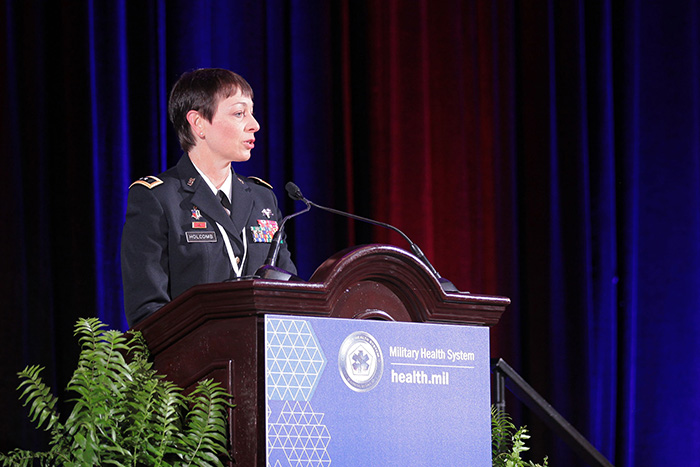Prolonged Field Care the New Normal says Army, MRMC Brass

"The battlefield of the future is already here," said Maj. Gen. Barbara R. Holcomb during her keynote speech at the 2017 Military Health System Research Symposium Aug. 28 in Kissimmee, Florida. "And so as a result, the medical force of the future must be here as well."
As the Commanding General of the U.S. Army Medical Research and Materiel Command and Fort Detrick, Maryland, Holcomb highlighted prolonged field care, which military leadership designated in a Capabilities Needs Analysis as the number one capability gap across the Army.
"We need to adjust both the way we think and the way we execute," said Holcomb. "And we need to understand that the multi-domain battlefield of the future will not always offer optimal –or even desirable– casualty care scenarios."
During her presentation, Holcomb described evolving technologies and supporting capabilities designed to support patient care in austere environments, including battlefields composed of far more dense and urban settings than current combat scenarios. These technologies include unmanned platforms to aid Warfighters in far-forward areas by delivering blood products and telehealth support. Holcomb also highlighted Army Medicine's investment in cutting-edge development in robotic surgery on the battlefield.
"This shift towards prolonged field care is a welcome challenge for both the Army and the Joint Program Committees," said Lt. Col. David Johnston, Combat Casualty Care Research Program military deputy. "For the CCCRP specifically, we are in a great place to leverage our current portfolio knowledge into positive, far-reaching change."
One example of that change can be seen in the Army's use of life support for trauma and transport – or LSTAT – technology. By integrating several miniaturized, commercially available medical devices into a self-contained platform that allows seamless transfer of a wounded Soldier from one echelon of medical care to the next, the Army is hoping the LSTAT will increase survival rates by putting sophisticated trauma equipment directly into the hands of medics on the battlefield.
For Holcomb, it's that type of thinking that represents the leading edge of a program-wide change that will likely set the tone for combat medical care for the next generation and beyond.
Said Holcomb, "The way we've been treating casualties in the past will not work in the future, and so our new reality begins now."
The MHSRS is the DOD's premier scientific annual meeting, which combines three previous conferences, including the former Advanced Technology Applications for Combat Casualty Care Conference; the Air Force Medical Service Medical Research Symposium; and the Navy Medicine Research Conference. By combining these conferences into one event, the meeting serves as a critical strategy session for leaders to set future milestones for the Department of Defense's deployment-related medical research programs, centered on the needs of the Warfighter.














